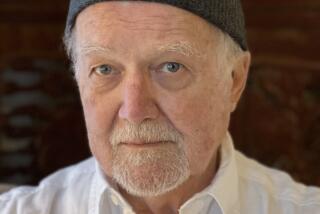Taking a page from Amy Tan
“The Joy Luck Club” is filled with ghosts.
Amy Tan’s four Chinese-born matriarchs call on ancient spirits for help and repress memories of brutality and heartache. Their daughters are haunted by their mothers’ high expectations, their own insecurities, and (being good Asian Americans) model-minority angst. In the end, nearly everyone finds some semblance of luck, if not joy, thanks to encounters with the “other” side -- what Tan has described as the elusive worlds of Fate and Faith.
Ghosts rarely travel in straight lines. Neither does this 1989 novel, a collection of parables and first-person accounts that zigzag between the epic and the intimate, from Old China to 1980s San Francisco. On the page, such stuff is magical. On the stage, it can be maddening.
“In terms of theater, it is really complicated,” says Susan Kim, who turned “The Joy Luck Club” into a play more than a decade ago. “It has challenges structurally because so much of it is ‘states of mind.’ What’s effective in the book fights against the way a play works, which is very much about forward movement and characters in conflict and high stakes.”
Tan’s reliance on multiple narrators makes things tricky, says Jon Lawrence Rivera, who is directing East West Players’ revival of Kim’s adaptation, which opens Nov. 12. “There’s a lot of ‘When I was 4 then da-da-da,’ ” he notes. “What they say may be engaging and profound, but we need to find ways to enhance the theatricality. Not that it needs more razzmatazz. But instead of an actor sitting in a chair talking to the audience, we are asking ‘What else can we do?’ ”
While pondering the answers, Rivera is taking care to preserve the emotional authenticity that has helped “The Joy Luck Club” resonate with audiences. Thanks to the poignant appeal of its central conflict -- the tug-of-war between mothers and daughters -- the novel was an international bestseller. Indeed, its popularity (as well as the release of a 1993 Wayne Wang movie) created another potential headache for Kim and company: comparisons to earlier incarnations.
Given all the challenges, why attempt a “Joy Luck” play? “Apparently, after the book was published, Amy Tan began hearing about unauthorized stage versions,” Kim says, “so she thought she would nip this in the bud by granting rights to a reputable theater” -- the Long Wharf Theatre in New Haven, Conn. The Long Wharf then approached Kim.
“I already knew the book,” she says. “It was a must-read for Asian American women.”
Kim also knew that condensing the elaborate opus would be daunting. She decided to reduce the material to essentials by making lists: “Which incidents were of the most dramatic value? Which were the most significant for each character?” In the theater, Kim explains, “there has to be a dynamic. It’s not just people contemplating life. There has to be an action, even if there’s just two people in a room.” She broke down each mother-daughter relationship into story lines, themes and overlaps. By arranging and rearranging index cards on a giant bulletin board Kim pieced together a game plan.
“In a traditional two-act play,” she says, “you have to create a situation in the first act that ends in a problem or a question -- an insecure place -- or else people won’t come back. The central question here is clear: The mothers feel disconnected from their daughters. The daughters each have crucial life problems with men or depression or lack of assertiveness.”
In the second act, she says, “the mothers tell their daughters stories about their lives. ‘This is what happened to me and I don’t what it to happen to you.’ These stories are gifts. The daughters eventually realize they can get some help or perspective from their mothers -- although they aren’t all successful at it.”
“The Joy Luck Club” opened in Shanghai in 1993 through a collaboration arranged by the nonprofit Yale-China Assn. The Long Wharf mounted the American premiere in 1997. Notable revivals have included productions by the Pan Asian Repertory Theatre in New York in 1999 and in 2007. This is its first Los Angeles staging.
What distinguishes East West’s version, says Rivera, is the attempt to “take leaps” and “build connections” by using music -- including a score by Hollywood composer Nathan Wang -- and finding ways to better integrate the many monologues into the action.
“Whenever you adapt a book into a play you have only so much time to tell the stories,” Rivera says. “Some things can get lost. We are trying to find details that are not in the text but can be given to the actor as a foundation.”
On the first day of rehearsal, the director says, he told his cast, “ ‘Think of the book as your friend. Read the stories and see how rich and deep the characters are. Use that knowledge.’ ” (Rivera also warned everyone not to watch the movie: “The performances can influence you so you act like someone else and not yourself.”)
Originally, each mother and daughter appeared on stage only when their stories were being told. “Once they finished they went away and the next mother and daughter came out,” Rivera says. “I thought each pair should be more actively involved in telling the whole story of the play. So now, the actors will take multiple roles.”
Cast members also will double as musicians a la John Doyle’s “Sweeney Todd.” “The actor who’s speaking will be like a soloist who is accompanied by other actors playing music and visibly participating in the story like members of an orchestra,” says Rivera.
Wang says he built the show’s score around “a Chinese melody I came up with, a simple tune that sounds very folkish.” It can be transformed into a dirge or a jovial wedding air and can be sung, hummed or performed on a cello or a Chinese gong. (Each mother-daughter pair will have its own signature instrument.)
Staging techniques aside, the production’s success rests with the eight women who, given little time or context, must conjure up vivid individual pictures and group portraits. Finding the right performers required rounds of auditions in which Rivera tested various combinations: “I wanted the temperament and quality to be the same and the fit and look had to be correct.”
Tim Dang, East West’s producing artistic director, had hoped to hire a female director for “The Joy Luck Club”; however, his top choices were unavailable. Rivera, the co-founder of L.A.’s Playwrights’ Arena, already had agreed to direct a musical for the company in 2009 and was happy to take over the project. He doesn’t think his gender is a disadvantage. “I have a very close relationship with my mother and my sister,” he says.
Besides, Rivera says, he grew up in a Filipino family of storytellers: “Either my mother or my aunties would start to talk and the others would support her and then become part of it by saying ‘Don’t forget this . . .’ or ‘What was the name of so-and-so?’
“The relationships and the stories are universal. That’s what makes this show work. There is always something that connects these women to our own real-life experiences.”
--
--
‘The Joy Luck Club’
Where: East West Players, 120 Judge John Aiso St., Los Angeles
When: Nov. 12-Dec. 7
Price: $40-$45
Contact: (213) 625-7000
More to Read
Sign up for our Book Club newsletter
Get the latest news, events and more from the Los Angeles Times Book Club, and help us get L.A. reading and talking.
You may occasionally receive promotional content from the Los Angeles Times.






